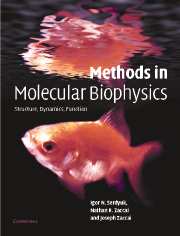Book contents
- Frontmatter
- Contents
- Foreword by D. M. Engelman
- Foreword by Pierre Joliot
- Preface
- Introduction: Molecular biophysics at the beginning of the twenty-first century: from ensemble measurements to single-molecule detection
- Part A Biological macromolecules and physical tools
- Part B Mass spectrometry
- Part C Thermodynamics
- Part D Hydrodynamics
- Part E Optical spectroscopy
- Chapter E1 Visible and IR absorption spectroscopy
- Chapter E2 Two-dimensional IR spectroscopy
- Chapter E3 Raman scattering spectroscopy
- Chapter E4 Optical activity
- Part F Optical microscopy
- Part G X-ray and neutron diffraction
- Part H Electron diffraction
- Part I Molecular dynamics
- Part J Nuclear magnetic resonance
- References
- Index of eminent scientists
- Subject Index
- References
Chapter E3 - Raman scattering spectroscopy
from Part E - Optical spectroscopy
Published online by Cambridge University Press: 05 November 2012
- Frontmatter
- Contents
- Foreword by D. M. Engelman
- Foreword by Pierre Joliot
- Preface
- Introduction: Molecular biophysics at the beginning of the twenty-first century: from ensemble measurements to single-molecule detection
- Part A Biological macromolecules and physical tools
- Part B Mass spectrometry
- Part C Thermodynamics
- Part D Hydrodynamics
- Part E Optical spectroscopy
- Chapter E1 Visible and IR absorption spectroscopy
- Chapter E2 Two-dimensional IR spectroscopy
- Chapter E3 Raman scattering spectroscopy
- Chapter E4 Optical activity
- Part F Optical microscopy
- Part G X-ray and neutron diffraction
- Part H Electron diffraction
- Part I Molecular dynamics
- Part J Nuclear magnetic resonance
- References
- Index of eminent scientists
- Subject Index
- References
Summary
Historical review and introduction to biological problems
1928
L. Mandelshtam and C. V. Raman independently discovered that a wavelength shift in a small fraction of scattered visible radiation depends on the chemical structure of the molecule responsible for the scattering. Raman was awarded the 1931 Nobel Prize in physics for the discovery of the phenomenon, which became known as Raman scattering or the Raman effect (Comment E3.1).
Comment E3.1
Mandelshtam–Raman phenomenon
In Russian scientific literature the effect is called the Mandelshtam–Raman phenomenon. We follow the more general usage and call it the Raman effect.
Raman scattering is inelastic light scattering that results from the same type of quantised vibrational transitions as those associated with IR absorption and occurs in the same spectral region. The Raman scattering and IR absorption spectra for a given molecule are often similar. Differences between the properties that make a chemical group IR or Raman active, however, make the techniques strongly complementary rather than competitive. Raman spectroscopy has the advantages of minimal or no damage to the sample, and relatively little interference from the water signal in aqueous solution or in vivo. The possibility of observing Raman spectra from crystals as well as from solutions in vitro or in vivo provides a very useful approach to relating molecular structures solved by X-ray crystallography and conformations in solution or in living cells.
Raman spectroscopy was not widely used by molecular biophysicists until lasers became available in the 1960s.
- Type
- Chapter
- Information
- Methods in Molecular BiophysicsStructure, Dynamics, Function, pp. 573 - 600Publisher: Cambridge University PressPrint publication year: 2007



